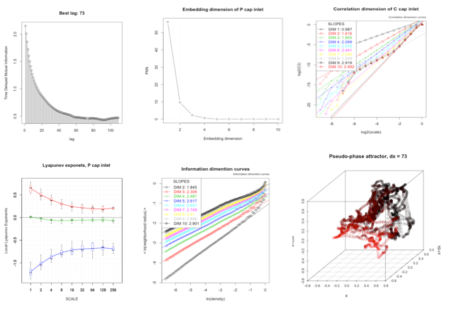Scientists and engineers simulate the flow of fluids through permeable media to determine how water, oil, gas or heat can be safely extracted from subsurface fractured-porous rock, or how harmful materials like carbon dioxide could be stored deep underground. Now, a scientist from Lawrence Berkeley National Lab has identified a causal relationship between gases and liquids flowing through fractured-porous media. They observed oscillating liquid and gas fluxes and pressures as the two transitioned back and forth within a subsurface rock fracture.

Evaluation of diagnostic parameters of deterministic chaos and 3-D strange attractor (bottom right) indicating that the system would behave within the boundaries of the attractor.
Summary
Identifying dynamic causal inference involved in flow and transport processes in complex fractured-porous media is generally a challenging task, because nonlinear and chaotic variables may be positively coupled or correlated for some periods of time, but can then become spontaneously decoupled or non-correlated. The author hypothesized that the observed pressure oscillations at both inlet and outlet edges of the fracture result from a superposition of both forward and return waves of pressure propagation through the fracture. He tested the theory by exploring an application of a combination of methods for detecting nonlinear chaotic dynamics behavior (Figure A) along with the multivariate Granger Causality (G-causality) time series test. Based on the G-causality test, the author infers that his hypothesis is correct, and presents a causation loop diagram (Figure B) of the spatial-temporal distribution of gas, liquid, and capillary pressures measured at the inlet and outlet of the fracture. The causal modeling approach can be used for the analysis of other hydrological processes such as infiltration and pumping tests in heterogeneous subsurface media, and climatic processes.
Citation
Faybishenko, B. (2017). Detecting dynamic causal inference in nonlinear two-phase fracture flow, Advances in Water Resources 106, 111–120, DOI: 10.1016/j.advwatres.2017.02.011
